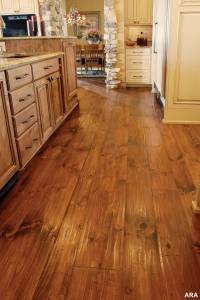 (ARA) – ‘Distress’ is not necessarily a bad thing if you are talking about wide plank hardwood floors. In fact, hand-distressing – the process of making new wood appear old is an increasingly popular design technique.
(ARA) – ‘Distress’ is not necessarily a bad thing if you are talking about wide plank hardwood floors. In fact, hand-distressing – the process of making new wood appear old is an increasingly popular design technique.
‘It’s not always feasible to use reclaimed antique wood to achieve a certain design effect,’ says Don Carlisle, second-generation owner of Carlisle Wide Plank Floors, a Stoddard, N.H.-based company that specializes in hand-distressing. ‘Homeowners who want to give their wood floors the look and character of age find hand-distressing is a great option.’
Distressing works best when done on old growth pine and other hardwoods. The process can be quite involved, with modern artisans often employing the same handcrafting techniques and tools used by craftsmen of long ago. Carlisle uses these techniques to recreate several identifiable looks associated with the wide plank floors installed in American homes more than 100 years ago.
Hand Scraped Edge
Lumber milling was an imprecise process in the 18th and 19th centuries. No two boards were ever exactly the same. When these imperfect boards were installed in a wide plank floor, it was not unusual to see individual boards laying side by side at different heights. To solve the problem (and avoid potential trips and falls), carpenters used a handheld block plane to scrape off the higher edges. This often left a slight gap between floorboards.
Today, Carlisle craftsmen use the same tool to mimic the look of a floor that has been planed through hand scraping of old growth eastern white pine. By randomly scraping down the edges of the board, that signature gap can be recreated when the boards are placed side by side. In fact, the craftsmen will occasionally place three or four boards together during the process to make sure the results look like an old, traditional floor.
Foot Worn
Standing on a floor visibly worn by centuries of foot traffic can make one feel linked to the past. Pockets, undulations, dips and softened edges in a wide plank floor speak of centuries of wear and a certain depth of character.
Carlisle craftsmen use handheld planes to scrape the surface and edges of each individual board. They study each board, and, taking into consideration the many directions of the grain as well as knots, scrape the wood with multiple starts and stops down the entire length. Once the scraping is complete, workers hand sand the entire surface of the boards, which are most often old growth hickory or walnut. Using this process, the craftsmen scrape an average of only15 to 20 square feet per hour.
Carriage House/Saw Kerf
After automobiles replaced horse-drawn carriages as Americans’ primary mode of transportation, many old carriage houses were converted to residences. Today, some still retain their original floors, where the marks of carriage wheels and horse shoes are still visible. Some even bear the grooves or notches – kerf marks – made by the saws or axes first used to cut the timber.
To replicate the look with modern wood, Carlisle craftsmen do not mill the planks smooth. Instead, they leave some of the original kerf marks in the wood. The marks cause the hand planes to strike and shave parts of the plank while skipping over other areas. This creates an uneven surface. Next, workers use a draw knife, pulled towards the craftsman’s body, to create a less drastic uneven edge. Finally, they hand sand the wood to help smooth out the surface while still allowing the kerf marks to shine through.
Many more authentic antique effects are possible through use of traditional methods. Because each board of every floor is hand crafted, no two floors are ever alike.
‘Hand distressing really evokes the craftsmanship and character of antique wide plank floors,’ Carlisle says.
To learn more about the many looks and methods of hand distressing, visit www.wideplankflooring.com, or call (800) 595-9663.
Courtesy of ARA Content
